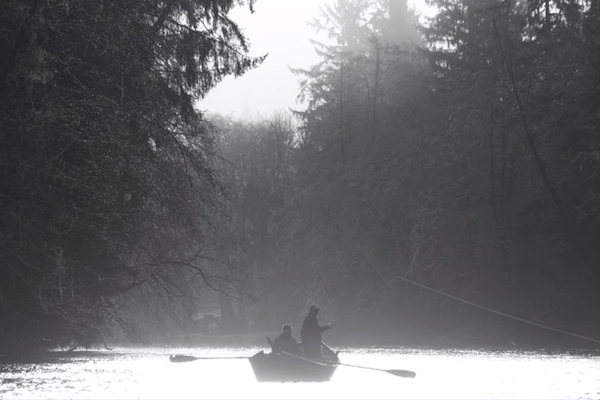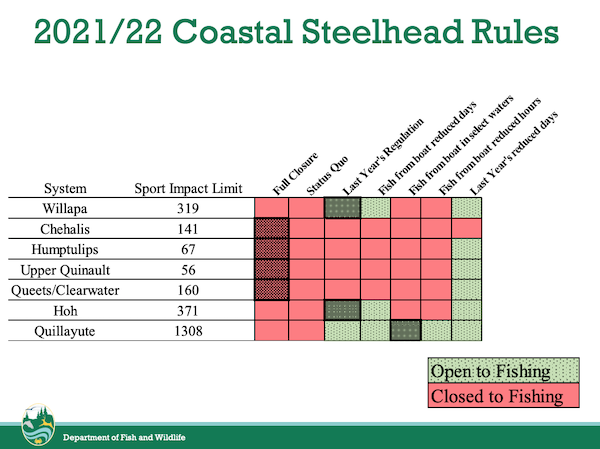
WDFW Set To Make Decision On Coastal Steelhead Season
It appears that Washington’s 2021-22 coastal winter steelhead season will feature limited boat fishing on portions of three Forks-area rivers, but also closures of four major systems, including the Chehalis.

WDFW Director Kelly Susewind must still sign off on this second year of heavy restrictions for streams from Forks south to Naselle, but a presentation posted ahead of tonight’s agency town hall outlines the probable rules.
To wit, they include:
Willapa System-Open December 1-March 31 (select tributaries Feb. 28th), selective gear rules, single point barbless hook, no fishing from a floating device, release wild rainbow trout, 2 hatchery steelhead bag limit.
Chehalis River-Closed through April 30. Treaty fishery closed.
Humptulips River-Closed through April 30. Treaty fishery closed.
Quinault River-Closed December 1-April 30. Treaty Fishery TBD
Queets/Clearwater River-Closed December 1-April 30. Treaty Fishery TBD.
Quillayute System-Open December 1-March 31, selective gear rules, single point barbless hook, no fishing from a floating device except mainstem Quillayute and below 101 bridges on Bogachiel and Calawah Rivers, release wild rainbow trout, 2 hatchery steelhead bag limit. Treaty fishery (48.7 days) expected catch 6% below allocation.
Hoh River-Open December 1-March 31, selective gear rules, no fishing from a floating device, release wild rainbow trout, 2 hatchery steelhead bag limit. Treaty Fishery (18 days) expected catch 13% below allocation.
Technically, those are “recommendations” to Susewind, but WDFW Fish Program Manager Kelly Cunningham said he had “every confidence” the rules as presented would be included in an agency news release expected to come out tomorrow.
He also said that WDFW “greatly appreciated” the hundreds of questions and comments from the public as this winter’s regulations were developed over the past few months.
It’s been a much more open process than last year, when fishing from a boat was closed coastwide and bait was banned as WDFW came down with an unprecedented set of blanket restrictions in reaction to very low forecasted wild runs.
Indeed, the 2020-21 native steelhead return was the “lowest on record” and this winter’s isn’t forecast to be much better, with the Chehalis, Humptulips, Quinault and Queets/Clearwater expected to all be below escapement goals.

It’s the same on Willapa Bay rivers, but there’s enough fish to open them under last winter’s restrictions. Per the statewide steelhead management plan, there’s a 10 percent impact limit on below-escapement streams, but unlike northern waters, there are no tribal steelhead fisheries in the bay’s rivers, meaning that that limit isn’t split with the comanagers. Between that and the restrictions, WDFW managers are “confident” they will meet return targets, but new this year, there will be creel sampling on South Coast rivers.
The Hoh and Quillayute systems are expected to meet escapement goals, and the former will be open under last winter’s rules, while the latter will feature boat fishing again on the mainstem and below Highway 101 bridges on the Bogachiel and Calawah. That will help anglers tap into 4,169 early and 578 late hatchery fish returning in December to the facility at the confluence of the Bogie and Calawah.
One angler warned that just because the lower Calawah would be open for boat fishing didn’t mean the rocky river was an easy one to run. Another Quilly trib, the Sol Duc, will not be open to boat fishing, apparently to protect its wild fish. Angling from drifters, pontoons and other craft is much more effective than from shore.

But the rules mean that early and late clipped fish won’t be able to be harvested on Grays Harbor’s and the Chehalis’s Humptulips, Wynoochee, Satsop and Skookumchuck.
Close watchers of the process were digesting tonight’s developments, with one person noting there was “a little bit for everyone.” In the leadup to this moment, a surprising number of anglers had called for a full closure this season, but it was also clear WDFW was trying to carve out opportunity where it could instead of redoing last year’s blanket approach.
Among the 160 or so people on WDFW’s Zoom call, David Moskowitz of The Conservation Angler called the bag limit of two hatchery fish on the Willapa, Hoh and Quillayute systems “excessive” because of potential encounters on early-returning wilds.
“It should be one and done,” he said.
WDFW coastal steelhead manager James Losee responded that 25 percent or less of anglers keep a pair of hatchery steelhead and that removing those fish keeps them from straying onto the spawning grounds.
He also acknowledged that a byproduct of wild steelhead conservation and closing angling was more hatchery fish to hatchery racks instead of anglers’ grills or ovens.
But Losee said that the suite of restrictions “set the table for fish to bounce back” once ocean conditions – “a major factor” – and freshwater habitat issues turn in the favor of steelhead.
Guide Bob Kratzer forecasted that boat fishing on the Quillayute waters would be closed at the end of January, after most hatchery fish had returned, but Losee said that there wasn’t a set of “backup” regs waiting in the wings, though emergency rules were always a possibility.
Christian Akers warned to guard against the idea of using boat fishing only over hatchery runs.
And with my youngest’s soccer tournament about to begin, that will have to be that for tonight. (Update: Ugh, blowout city.)
